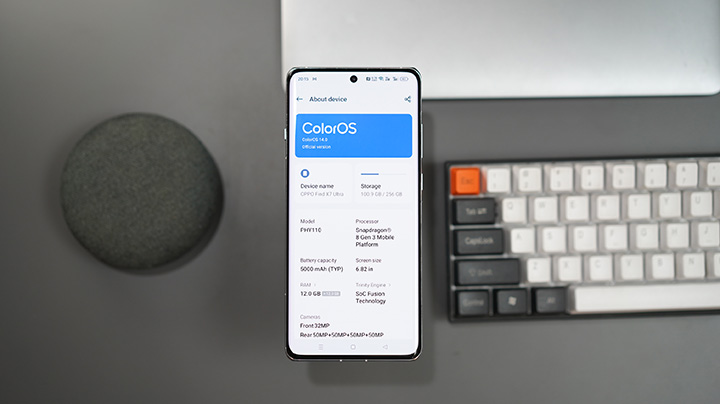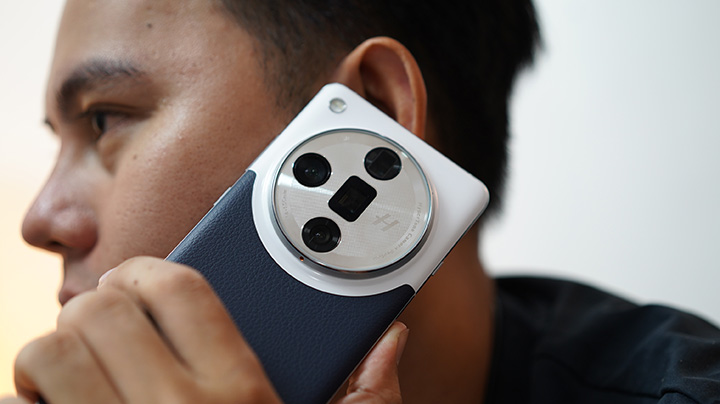For the longest time, regional execs of OPPO 10 have maintained that the “Flip” series will be their flagship offering in the Philippines for the time being. All this might soon change as we’re hoping to see the Find X series arriving in the Philippines later this year.

While we’re told it’s not going to be the Find X7 Ultra, we’re assured it will be the successor. So, it’s just timely we’ve had the chance to take the Find X7 Ultra for a spin and share with you our findings in this full review.
Table of Contents
We are going to state the obvious here — the Find X7 Ultra is a huge-ass smartphone, measuring 9.5mm in thickness and weighing 221 grams. It’s right up there among other heavyweights (literally), like the Xiaomi 14 Ultra (9.2mm, 220 grams) and the Honor Magic6 Pro (8.9mm, 225 grams).

Putting aside that humongous profile, we actually liked the design of the Find X7 Ultra, especially the leather and glass back panel. But we’ll get to that later.
On the right side, we have the power button and volume rocker; surprisingly, there’s a VIP Slider on the left side, a feature similar to the Alert Slider popularized by OnePlus. The slider includes a VIP Mode, which blocks access from the mic, location, and camera for greater privacy (if you’re that paranoid).

Up top, we have the 2nd speaker grills, a noise-canceling microphone, and an IR blaster. At the bottom end, we have the primary speaker grill, USB Type-C charging port, the primary mic, the SIM card slot, and what could be an air vent hole.

The front display has a curved glass that meets the back panel along the sides with the tapered edges to make handling more comfortable.

Despite the rather thick profile, the Find X7 Ultra feels solid and well-balanced in the hands. The stainless steel frame feels cold but comforting with its shiny, polished finish that fuses with the glass display and the two-tone glass and leather back panel.

That faux leather has a nice soft texture on the back panel meets the glossy ceramic finish halfway around the camera module makes for an interesting aesthetic.

The device also has an IP68 rating, making it completely dust-proof and waterproof at 1.5m underwater and up to 30 minutes. Just don’t forget to skip the swimming pool or beach as the proofing is not suitable for that.
The OPPO Find X7 Ultra features a quad HD+ resolution (1,440 x 3,168 pixels, 510ppi), measuring 6.82 inches and uses an LTPO AMOLED curved 3D display. It has an outdoor brightness of 1,600 nits (2,600 nits HBM) and 4,500 nits peak brightness.

The display is protected by Gorilla Glass Victus 2 with a screen protector already pre-installed. Suffice it to say, the screen on the Find X7 Ultra is one of the nicest we’ve seen – very bright, colors are vibrant but even and balanced, has high contrast with deep blacks and images are sharp and crisp.

To optimize all this display goodness, you can tweak the settings to Auto-select resolution based on content or pick a default (2376×1080 or 3168×1440) resolution. The same with refresh rates – standard (60Hz), High (up to 120Hz) and auto select (1Hz to 120Hz).
While others might find the curved display a bit jarring, especially when playing games, we think it’s an essential design aspect that makes the device feel thinner and more manageable than it actually is. The bezels are barely noticeable as well due to the curvature.

There is a punch hole in the upper section of the display to make way for the selfie camera. An earpiece is placed along the border of the glass and the metal frame, just at the edge of the display, which is a very thin and almost unnoticeable slit for the earpiece.
For security, you can use the usual password options or enroll your face and/or fingerprint for better protection. The Face unlock works very well and even registered my face while using my eyeglasses and also recognized the same very quickly. The under-display fingerprint sensor is also placed somewhat near the middle of the screen but can still be easily reached. It is fast and accurate, and we have nothing to complain about.
Where the Find X7 Ultra really shines the most is with the quadruple main camera system.
The large camera module at the back houses 4 large lenses with the main one using a Sony LYT-900 1-inch type sensor, the successor to the Sony IMX989. It has a f/1.8 aperture, 23mm focal length, and has built-in optical image stabilization.

For ultrawide, it has another 50MP Sony LYT-600, a 1/1.95-inch sensor with a 14mm focal length and f/2.0 aperture. It can also take macro shots with objects as near as 4cm.

For zooming in, the Find X7 Ultra comes with 2 periscope cameras – a 3x zoom powered by a Sony IMX890 (1/1.56”, f/2.6, OIS) at 65mm focal length and a 6x periscope lens powered by a Sony IMX858 (1/25.1”, OIS) with an equivalent 135mm focal length.
With the entire lens system, you get a smooth uninterrupted zoom capability from 0.6x to 6x or an equivalent of 14mm to 135mm. Or, using the hybrid AI-optimized zoom, all the way to 200mm. You can also extend this up to 120x digital zoom if you want.
The main 23mm camera takes slightly wide and perfect for general-purpose photography, street photography and a little landscape shots.
Another great example of the power of the camera is with taking portrait shots. For close-up shots or group shots, the 23mm and 65mm are both great. You can even go with 6x camera if the situation requires it.
Here are some samples we were able to take with the 65mm lens.
Here’s the one using the 135mm lens for portrait.
In these samples, you can see the clarity, detail, balance of colors and separation of the subject from the background.
One great feature we found with the Portrait Mode is the ability to change the aperture after you shot them – usually from f/1.4 to f/16 so you can further blur the background from your subjects.
With the right photo, it works wonders in further adding bokeh to the background.
Note, though, that this only works with the background and not the foreground, as in the example above.
In more complex or complicated shots, such as the one above, the blurring will be very limited.
The 14mm wide-angle camera shows clear detail around the center, with a slight distortion around the corners in some shots.
Night shots are also something to look into, and the Find X7 Ultra does not disappoint either.
It’s pretty evident that OPPO has maximized its partnership with Hasselblad when tuning these cameras, as we can see in the shots produced, especially when taking those stunning portrait photos.
If you’re a hard-core Hasselblad fan, the camera Master Mode follows the same characteristics as the Hasselblad X2D 100C. It also features RAW MAX which is 50MP of RAW in 16-bit color and up to 13-stops of dynamic range. You can then adjust and edit the RAW files in Adobe Lightroom.
For video recording, OPPO limited it to just 4K @ 60fps AND 1080P @ 60FPS but added 10-bit support and HDR. While it lacks 8K video recording, we’re not missing that feature because we’ve never really shot 8 K videos in any practical situation. What we appreciate, though, is the slow-mo capability for 1080p @ 240fps in all three cameras (0.6x, 1x, and 3x zoom).
The video quality is stunning—the level of clarity and detail is something we rarely see in a camera phone. Stabilization is almost spot-on, though there will be occasional wobbling or floating (slight) clips. Overall, the video quality across all cameras is impressive.

As for selfies, the 32MP front camera uses a Sony IMX709 with an aperture of f/2.4 and a 21mm focal length, PDAF that can record 4K@60fps.
We think OPPO intentionally made all five cameras shoot at 4k@60fps, so whichever you use will all produce almost the same quality and resolution.

OPPO also debuted the Hypertone Image Engine in the Find X7 Ultra, a feature that combines hardware and software optimization with AI enhancements to promise an increase in image clarity of 30% and a reduction in noise of 60%.
The OPPO Find X7 Ultra took the #1 spot in DxOMark’s global ranking for smartphone cameras last March 13, but that was quickly replaced by the HONOR Magic6 Pro less than a week later and has recently been pushed down the rankings again by the Huawei PURA70 Ultra.
This does not take away the fact that the Find X7 Ultra is still a beast in terms of photography.
Overall, we’re pretty satisfied — no, slash that — impressed with the Find X7 Ultra in the camera department. The Hypertone Image Engine and Hasselblad partnership has really showcased the unique camera signature of the Find X7 Ultra.
The review unit that we have is based on the China-ROM, so we’re getting a lot of unrecognizable Chinese apps and features pre-installed right out of the box. There are also some Android features that would not work, like Android Auto (we installed it after the fact), which requires it must come with the handset, or it won’t work (we tested it on our Ford Territory).

Some of the built-in features are also in Chinese language, so we weren’t able to play much with them. One is the Xiaobu, which activates when you press the home button for more than 2 seconds. This is an AI assistant that works like Siri and is part of the recent ColorOS AI feature released last March and powered by OPPO’s AndesGPT. Surprisingly, you still have Breeno Assistant baked into the system along with Breeno Suggestions and Breeno Touch, features that offer Onscreentips, Ai summarizer, and Extract text from screenshots.

If you sign up with AndesGPT, you can also activate new features such as AI Eraser, Call Summary, and Article Summary, although we already tried AI Eraser from the Photo Gallery without going through the registration.

Otherwise, you’d see most of the familiar features of OPPO’s ColorOS 14 based on Android 14. However, based on our experience with ColorOS, it is very versatile and highly customizable that you can tweak it all you want to fit your needs or taste.
We won’t dig any deeper into the OS since this isn’t really a global ROM anyway.
Powering the Find X7 Ultra is the latest Qualcomm Snapdragon 8 Gen 3 chipset. This is composed of a single Cortex-X4 processor running at 3.3GHz, a triple-core Cortex-A720 at 3.2GHz, a dual-core Cortex-A720 at 3.0GHz, and a power-efficient dual-core Cortex-A520 processor running at 2.3GHz.

The chipset also includes an Adreno 740 GPU, which is paired with 12GB of fast LPDDR5X RAM and 256GB UFS 4.0 internal storage.
The chipset + LPDDR5X RAM and UFS 4.0 storage combo is what makes the device perform at its best.
Our suite of benchmarks showed the Find X7 Ultra pumping out impressive numbers we rarely see these days, even with so many other flagship devices we’ve tested.

It’s only one of two smartphones we’ve tested that surpassed the 2 million mark in Antutu benchmark (based on our own test results, others may vary). The other one is the ASUS ROG Phone 8 Pro from last March.
Check out the results below:
Antutu Benchmark v10: 2,026,355
Antutu Storage: 3,903 MB/s (Read), 3,035 MB/s (Write), 1,789 MBs/s & 961 MB/s (Random Read/Write)
PCMark Work 3.0: 14,276
GeekBench 6.3 CPU: 936 (Single core), 4,908 (Multi-core)
GeekBench 6.3 GPU: 13,526 (OpenCL), 15,913 (Vulkan)
Suffice it to say we’re impressed with the performance of the Find X7 Ultra. Works flawlessly, loads apps and games in a jiffy, and handles multi-tasking or switching between apps without flinching.

The only issue we found is that when using the camera for shooting photos and videos in the outdoors for about 30 minutes to an hour, the phone does feel warmer than normal. We observed this during our photo shoot in Thailand.
In any other situation, the Find X7 Ultra works flawlessly with anything we throw at it – from graphics-intensive games to loading and switching through dozens of apps.
The Find X7 Ultra comes with a 5,000mAh battery, which is already satisfactory but we were hoping it would be more, considering the thickness and weight of the device.

Using the PCMark Work 3.0 Battery test, the Find X7 Ultra got a score of 10 hours and 54 minutes; while in our video loop test, the device got 22 hours and 30 minutes playing a full HD video. Both tests were set at 50% brightness, zero volume, and in airplane mode.
When tested for gaming, we played a few Ranked games in Mobile Legends on the Find X7 Ultra, which got about 6 hours and 30 minutes of gameplay on a single full charge.
The device came with a 100W SUPERVOOC charging brick, and when we tested the charging speed, we recorded about under 30 minutes from zero to fully charged. It also comes with a 50W wireless charging capability that can fill up the battery in just 60 minutes.

In terms of connectivity, we have everything in place – WiFi 7 support, Bluetooth 5.4, NFC, GPS, and 5G network support from the nano SIM trays. There’s no eSIM support, but OPPO baked-in ORoaming support in case you want roaming data connectivity when traveling abroad.

Again, you also have the infrared blaster, which can be used to pair with any IR-based appliance at home or in the office. Simply add them via the pre-installed Remote app.
OPPO continues to make its Find X series one of the best flagship smartphones out there and the Find X7 Ultra makes for a great example. OPPO paid a lot of attention to camera quality and the Hasselblad partnership to make a unique and compelling statement.

A great design, solid build and quality, top-notch performance, and beautiful display aren’t enough these days for a true flagship smartphone. It also has to have an impeccable taste in photography – one that has a distinct signature and something OPPO can really call its own.
The OPPO Find X7 Ultra has all that and then some.
Unfortunately, the Find X7 Ultra (including the entire series) will not be officially released in the Philippines. OPPO Philippines has commented though that its successor, the OPPO Find X8 series, will be launched in the 4th quarter of 2024 and will be released in the country.
What we liked about it:
* Top-notch performance
* Impressive quad-camera system
* Super-fast charging
* Nice design and build quality
* Brilliant display
What we did not like:
* Thick and heavy
* Average battery life
OPPO Find X7 Ultra 5G specs:
6.82-inch LTPO AMOLED curved 3D display @ QHD+ (3168×1440 pixels)
120Hz adaptive refresh rate, 1600 nits (peak brightness)
Corning Gorilla Glass Victus 2
Qualcomm Snapdragon 8 Gen 3
1x Cortex-X4 @ 3.3GHz, 3x Cortex-A720 @ 3.2GHz, 2x Cortex-A720 @ 3.0GHz, 2x Cortex-A520 @ 2.3GHz
Adreno 740 GPU
12GB, 16GB RAM (+12GB RAM Expansion)
256GB, 512GB UFS 4.0 internal storage
50MP f/1.8 Sony LYT-900 main wide 1G7P lens with AF, OIS
50MP f/2.0 Sony LYT-600 ultrawide
50MP f/2.6 Sony IMX890 telephoto 1G3P Lens AF with OIS
50MP f/4.3 Sony IMX858 telephoto 1G3P Lens AF with OIS
32MP f/2.4 front camera 5P Lens AF
4K@60fps/30fps, 1080P@60fps/30fps, 720P@30fps
Dual Nano-SIM
WiFi 6E
Bluetooth 5.3
NFC
USB Type-C
IR Blaster
Fingerprint sensor (in-display)
ColorOS 13 (Android 13)
5,000mAh battery
100W SuperVOOC charging
164.3 x 76.2 x 9.5 mm (dimensions)
221 grams (weight)
Desert Silver Moon, Smokey Purple, Starry Black (colors)

YugaTech.com is the largest and longest-running technology site in the Philippines. Originally established in October 2002, the site was transformed into a full-fledged technology platform in 2005.
How to transfer, withdraw money from PayPal to GCash
Prices of Starlink satellite in the Philippines
Install Google GBox to Huawei smartphones
Pag-IBIG MP2 online application
How to check PhilHealth contributions online
How to find your SIM card serial number
Globe, PLDT, Converge, Sky: Unli fiber internet plans compared
10 biggest games in the Google Play Store
LTO periodic medical exam for 10-year licenses
Netflix codes to unlock hidden TV shows, movies
Apple, Asus, Cherry Mobile, Huawei, LG, Nokia, Oppo, Samsung, Sony, Vivo, Xiaomi, Lenovo, Infinix Mobile, Pocophone, Honor, iPhone, OnePlus, Tecno, Realme, HTC, Gionee, Kata, IQ00, Redmi, Razer, CloudFone, Motorola, Panasonic, TCL, Wiko
Best Android smartphones between PHP 20,000 - 25,000
Smartphones under PHP 10,000 in the Philippines
Smartphones under PHP 12K Philippines
Best smartphones for kids under PHP 7,000
Smartphones under PHP 15,000 in the Philippines
Best Android smartphones between PHP 15,000 - 20,000
Smartphones under PHP 20,000 in the Philippines
Most affordable 5G phones in the Philippines under PHP 20K
5G smartphones in the Philippines under PHP 16K
Smartphone pricelist Philippines 2024
Smartphone pricelist Philippines 2023
Smartphone pricelist Philippines 2022
Smartphone pricelist Philippines 2021
Smartphone pricelist Philippines 2020